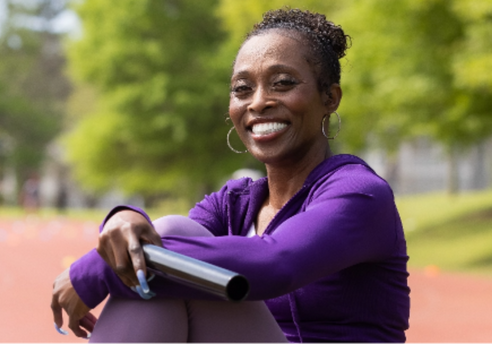



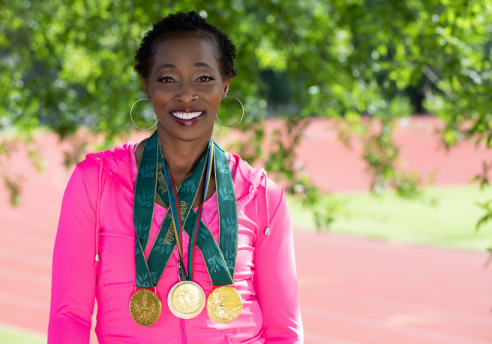







Gail Devers is a world-renowned track star and three-time Olympic gold medalist who has been living with Graves’ disease and symptoms of Thyroid Eye Disease (TED) for more than 30 years. After a harrowing two-and-a-half-year quest for answers, Gail was diagnosed with Graves’ disease in 1990, just two years before winning her first Olympic gold medal. Her journey back to the track was nothing short of remarkable as she struggled with near career-ending symptoms, including extreme weight loss, tiredness, and insomnia. During this time, Gail also experienced eye symptoms including eye pain, bulging eyes, and light sensitivity, but she was never told that these eye symptoms could actually be a separate, but related, disease called Thyroid Eye Disease (TED). That’s why Gail is helping educate others living with Graves’ to focus on their eye health, so they can get the specialized care they need.
Watch the video below to hear her inspiring story, and listen to her podcast interview here.
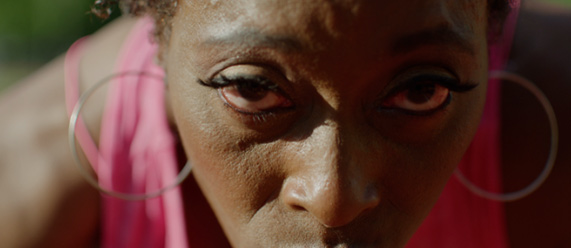
Every doctor I saw told me:
As an athlete, I know my body and I knew something wasn’t right.
It’s 1988, I’m an American record holder in the 100 meter hurdles and headed to my first Olympic games in Seoul, Korea. I was living my dream.
But something was ‘off.’
Suddenly I was running slower than I ever had, and I didn’t make the finals.
I had dropped from 120 pounds to 80 pounds before I stopped looking at the scale.
My face was discolored. My skin was scaley, and my hair was falling out. I was tired all the time and yet I wasn’t getting any sleep.
I had trouble with my eyes, too. They hurt. They were bulging, irritated, and dry, and I couldn’t close my eyes fully when I slept.
Still, every doctor told me that there was nothing wrong.
Meanwhile, my training came to a stop, I covered up all the mirrors and I just wanted to black out the world. I felt like I had lost myself. I was desperate for answers. I just wanted to get back to being the ‘old Gail.’
Every day of my two-and-a half year quest for answers, I visualized myself getting back to the Olympics. I saw myself running my race, and I could see myself crossing that finish line.
Then finally, after almost three years of searching, I was diagnosed with Graves’ disease. I still had my goals and my dreams, so now I could start getting my life back on track.
With my Graves’ disease under control, and a lot of grit and determination, support from my coach and my family, two years later, I won my first Olympic gold medal.
I remember during my victory lap the camera man said, “Slow down. You’re supposed to enjoy this!” And I told him, “Look, you’d better keep up, ‘cause you don’t know what I’ve gone through!”
For more than 30 years now, I’ve been living with, and managing, my Graves’ disease. But in all these years, not a single doctor ever mentioned my eye symptoms were separate from Graves’.
I thought my eye symptoms were just part of Graves’ disease, but now I know they could be associated with a related, but separate, condition called Thyroid Eye Disease. This is something I wish I’d known all those years ago.
I still struggle with red, irritated eyes, eye pain, and light sensitivity today.
And that’s why I want to educate others.
First, know the symptoms of Graves’ disease. If you have a combination of weight loss, trouble sleeping, hair and skin issues, talk to your doctor.
Next, if you have Graves’ disease, focus on your eye health.
Up to 50% of people with Graves’ disease will develop Thyroid Eye Disease.
If you notice any changes in your eyes, like eye bulging, light sensitivity, or eye pain, don’t just assume they’re part of Graves’ disease.
Be your own best advocate. Write down the symptoms and report them to a TED Specialist.
Find a nearby TED specialist at TEDdoctors.com and make an appointment.
No one should ever go through what I’ve been through. But despite all the physical and emotional hurdles I’ve faced, I wouldn’t change my experience. It’s only made me stronger.
Now, my goal is to help others get the answers that they deserve. Always look past the hurdle; and focus on what comes next.
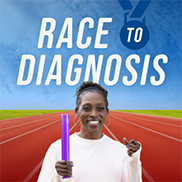


Take part in the Race to Diagnosis game to see if you can beat Gail.
‘Portraits of Life with TED’ is a first-of-its-kind documentary that explores life with TED through art. Three patients living with TED share what it’s really like to live with the disease with accomplished artist Rachel Mindrup, who captures unique portraits for each person. This moving documentary highlights intimate reflections on life with TED and shares behind-the-scenes footage of the unique portrait creation process.
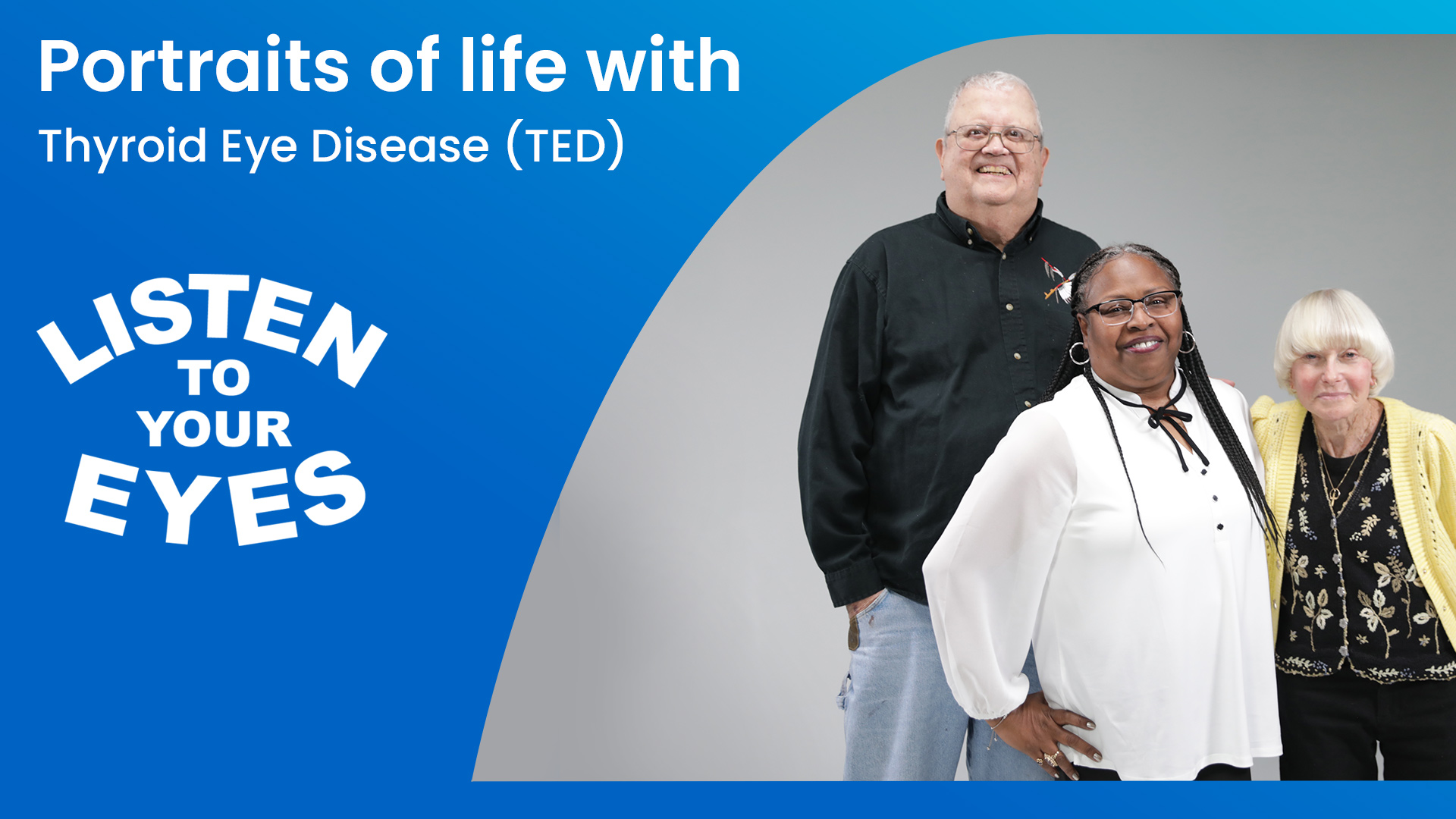
LaQuilla: Thyroid eye disease is like your eyes are full of sand from the beach. That is how dry they are. They get dry, they get teary and they begin to protrude. They bulge out. Like you’ve been shot. I’ve had a total of eight surgeries. Thanks to all eight of those surgeries, I know have vision. I still don’t have the true vision that I need today but I am grateful for where I am.
Thyroid Eye Disease (TED) is a lifelong, autoimmune condition that affects the eyes.
Signs and symptoms vary person-to-person and can include dry, gritty eyes, watery eyes, redness, light sensitivity, eye pain, double vision or eye bulging.
In a 2023 survey of people living with TED, the most commonly reported symptoms were: Dry eyes (77%) Irritation or redness (65%) Eye Pain (61%)
Up to 50% of people with Graves’ disease may develop TED.
Jake: I was diagnosed with Graves’ disease quite unexpectedly in the Navy reenlistment physical. And after that, it just continued to get worse. Couldn't drive to work unless it were a patch. So I'm at the point right now where I've had 22 eye surgeries I've been left with permanent double vision.
Christine: I really clung to my day to day life, just I was not going to let it go. I love to be outdoors, but the light was burning my eyes. But instead I just got bigger glasses So I just, you know, I, I kept trying to adapt to things.
TED affects each person’s life differently - every person’s journey with TED is unique to them.
We invited Rachel Mindrup, a visual artist and rare disease advocate, to paint unique portraits of three people living with TED.
Rachel: I can't remember not having art be a part of who I am? I got into working with using my art with people with rare diseases, specifically neurofibromatosis, simply because my oldest son was diagnosed with neurofibromatosis when he was four months old and probably similar to many people when they encounter a rare disease.I hadn't heard of it. And at that time I was really frustrated that nobody had heard about it. And nobody I mean, how are how are his teachers supposed to help him if they don't know what that is. And so to be perfectly honest, since I wasn't raising awareness and I really wasn't doing anything, I kind of got on social media and found people who had this rare disease who were advocates and the best thing I can do is paint a portrait to say thank you.
Rachel sat down with Christine, Jake and LaQuilla to learn about their TED journey while she sketched a plan of what their portrait would look like.
Rachel: Hey, how you doing?
Christine: I'm good. How are you? Good.
Rachel: Have a seat. Get comfortable.
Christine: Thank you so much.
Rachel: Have you ever had anybody draw or paint your portrait before?
Christine: No.
Rachel: Excellent. Then I have nothing to be compared to. So today's can be fun. I want to find out what we're going to be doing, what we're going to be painting, how you want to be depicted and I get the privilege to figure out how to depict all three of these individuals the way they want to be presented to the public, which is kind of exciting. You know, who is Jake? Like, what does he enjoy doing? And oh, by the way, he has TED. The diagnosis is secondary to who you are no matter what you're living with. Portrait painting is a slow process. Don't let anyone tell you different but I like that. So I think there's something nice and magical in the fact that I'm going to spend some time with these people I like that. I think that gives it a a deeper meaning and a and a deeper relationship and connection.
Rachel: Have you some hobbies or some other things that you think would make for kind of an interesting, interesting image?
Christine: I love to be in motion. And my favorite ways are my bicycle. My bicycle and I are we have a longstanding relationship. And so I live in Monterrey right on the coast, Monterey, California.
Christine: Rachel asked me to bring a photo of myself, and so when I chose was We live in Monterey, and this is Lovers Point in Monterey, and it's myself and my husband. And I was telling her about these little dresses that I wear it's just being with him in the setting, which I hope I will always live there. And yeah, so that's why I chose this photo.
Rachel: So I am curious, as somebody who doesn't live with TED, um, I truly don't know. Does having TED impact, like, bicycling,
Christine: It did at one time, definitely. I didn't stop doing them, but it did impact me.
When symptoms are at their worst, adults with TED most frequently report their symptoms have made it difficult to do their jobs, avoid social gatherings or go out in public, drive, or use their mobile devices.
Christine: So, the first thing I actually noticed was light sensitivity. So I would you know, I was raised in Southern California and very used to being outdoors by the beach, you know, sunglasses or not. But it became very light sensitive to wear even a light in a room could just like burn my eyes. Eventually when I got surgeries, I had six surgeries on my eyes. Six, seven surgeries. And one of the surgeries, they move my eyes back into position. They were they came way out and they were like just dangling. And so when they put when they put my eyes back in on one of the surgeries it created just a horrible, chaotic double vision.
Christine: I first noticed the symptoms in 2009, you have to fight really hard to keep your confidence level up, because when your physical appearance, especially your face, is, you know, out of your control, just you know, your whole face changes and not for the better. Emotionally, that is a difficult thing to deal with one thing is I stop looking people in the eye. I just relearned how to do that, but I could not make eye contact because I wouldn't want people looking at my eyes. So I would always be like looking away. So that was an emotional, you know, mountain. you could walk in a room and people would like look towards me like, Wow, what's wrong with her? And that's a really lousy feeling.
In a survey of people living with TED, 76% revealed their eye symptoms affect their emotional well-being moderately or severely.
Well over half (59%) of adults with TED surveyed say they would rate their emotional well-being and quality of life as fair or poor when their TED symptoms are at their worst.
Christine: The healing is really in reaching out. It's not in withdrawing. There's no there's no benefit to withdrawing, but there's tremendous benefit to reaching out. And that is where I want to give the encouragement.
Rachel: What do you think going forward with this painting? Like what do you think you would want to be doing in the painting?
Jake: You know, I've been fascinated with aviation since I was 12. and I said, I'm going to work on them one of these days. And when I joined the Air Force, I ended up being an F1 mechanic and prior to that I was always interested making model airplanes, gliders. And so I worked on jets fighter jets in the Air Force, and then I got out and went to work in. I got a phone call to go work on the space program. My last 27 years I worked on the space program. Yeah, Shuttle Atlas, Delta Titans. And so my whole life has been aviation.
Jake: Well, I like that Rachel asked me questions about what I what I like to do and what I might like to have the portrait look like. I originally said this photograph, which was when we did a filming with Gail Devers and her and I actually had a lot in common. That's what I was thinking was we were both diagnosed within about three months of each other. It started out going to be this picture, and then it ended up me building a model airplane. I do that. So, if she's going to capture me sitting underneath my magnifying glass, working on air model airplane that I'm later going to be able to actually physically take out and fly. That's pretty cool.
Rachel: So I'm thinking something where we can have you looking down like this, like a little bit, looking down, working on your airplane. Is it one of those round ones for you? The magnifying glass?
Jake: Yeah, The big man. Yeah.
Rachel: So today's been an education for me, so I have to ask, with all these different jobs that you've talked about working through, I mean, did your TED have any impact on, on being able to do that?
Jake: Yes. Actually, I was working for the space program. I was a Navy reservist and they found my I found I had Graves’ and TED at the same time.
Rachel: And that seems actually that seems kind of different than other.
Jake: It is very different. I was doing my Navy physical and my heart was 168 beats a minute. So they sent me to the E.R. for they thought I was having thyroid storm. There is an endocrinologist at the E.R.
Rachel: So there's an endocrinologist in the E.R. when you went?
Jake: Yeah, I was just lucky that he happened to be kids that day. I was just pure, pure luck. Yeah.
Rachel: It is kind of interesting, just at least from the conversations I've had today, that that you would get them both diagnosed at the same time.
Jake: So that's very rare.
Graves’ disease and TED are separate, but related, conditions that require different doctors and different medicines for treatment.
Rachel: Well, so that's kind of interesting, though. So in some regards, though, like what about family and stuff? Did didn't I mean, if we're looking at pictures of you four years ago, two years ago now, like when you your family have noticed.
Jake: No. So gradual, you just don't notice.
Rachel: Oh, so then they just get used to it.
Jake: They just get used to it as a as it gradually gets worse. That's just how you look.
Jake: Prior to my decompression, as I was starting to lose my color vision and I was getting to the point where my eye doctor in Miami said, “Jake, I think you're going to have to go to the Association for the Blind and start to learn how to live with love is because if this doesn't work, you will lose your sight.” I never thought about being blind. That was very scary. I wanted to see my my family grow up and be a grandfather, which I am now to two granddaughters, and I'm getting to watch them grow. So that's how important it is to me.
About 2 in 5 adults with TED claim they find it difficult to tell their doctor about the impact TED is having on their daily life.
Speaking up and advocating for what you need is important to getting the right care.
Rachel: So, what other hobbies?
LaQuilla: I'm an outdoors girl. Picking pecans off the tree once somebody else climbs it and shake it.
Rachel: Picking pecans? That would be an awesome painting. Hmm. Mm. I have never painted anybody picking pecans from a tree and enjoyed doing it?
LaQuilla: I do.
Rachel: What are your thoughts about that for a painting?
LaQuilla: That's wonderful. Okay, that's home. That's home. That's what I'm used to. That's what I grew up doing.
Rachel: Picking pecans. Can you just eat them straight like that too?
LaQuilla: Yes. Once we pick them up. Mm hmm.
Rachel: Okay. Oh, my gosh. I don't know what a pecan tree looks like. So I have to go. I'm going to have to go look that up. I've got some ideas. You can tell me.
LaQuilla: I like the fact she is going to do a little homework and find out what a pecan tree looks like. Yeah, I can appreciate all the things that she's going to do. She's had pecan pie, but she's never seen the tree and where the pecans come from. And I'm looking forward to it. It's exciting, too, because I've never done anything like this before.
Oh, this is my favorite photo. This wreath that's hanging on my door was made for me. My cousin had it made for me because she knows that Alabama is my favorite college team. I have on the purple, which has always been my favorite color. This picture means a lot. Just like watching a tide roll in. And that purple is so royal. That also helps me with who I am because that's a powerful color. It keeps away negativity. This is why I was able to stay strong in my head while I'm going through TED because of that royalty.
Rachel: Family members and stuff that also?
LaQuilla: Well, they didn't know at the time what I was going through. I couldn't share it with them because I didn't know what I was going through myself.
Rachel: Oh, okay. Um, until you got, like I said, until you finally got the diagnosis in 2006.
LaQuilla: Well, by that time I was totally blind, so, you know, I didn't really. Yeah, by that time I had already lost the right eye. So I'm like, okay. But just to be told that you would never see again, can you imagine having your sight all that time? And then you get hit with these rare diseases and you're told you're never going to see again?.
LaQuilla: Because everything was going on for so long undetected. When I had lost the sight in my left eye. I begin to rapidly lose sight in my right eye. I never went out. I would let nobody see me. I covered all the mirrors in the house because I didn't want to see myself. The key is just to tease and say, my God, look at the monster. It was a mental experience that I'll never forget because all I could do was cry.
Around 1 in 4 healthcare providers say their patients with TED rarely or never bring up the impact of the disease on their mental/emotional health.
Less than than 2 in 5 adults with TED report telling their doctor about the impacts that the disease has on their mental or emotional well-being at every appointment.
Sharing how TED is affecting emotional well-being and daily activities is just as important as reporting physical symptoms.
LaQuilla: Never give up. Don't quit. Find out who you are. Pull their strength from inside of you and say, I can beat this.
Rachel: Once you get a diagnosis and once you get a name for it, that also means that you suddenly will start surrounding yourself with others that have it. A bit of a community.
LaQuilla: No, not just not right away. Cause I had to take it all in, right? You know, I became a like a recluse. I had to be to myself and figure out what this disease was, since it didn't have any vision to look it up, read about it. I had to wait. I just had to go through what I was going through. And actually my sight was restored January of 2012. Well, so I'm celebrating 11 years with vision. It may not be 20/20 vision, but it's vision. It's vision. You know, when you're going through trials, testing your help, when you lose your sight, not really knowing if you're going to get it again, it makes you stronger than what you really are. Where I thought I was weak, I was actually at my strongest point ever.
LaQuilla: She doesn’t know about TED so each story that she hears, she gets a little bit of information from each person who is living with Ted and who has met her. And I think that's a good thing because we're more vulnerable with her so she can paint that through the arts.
Christine: She’s super easy to talk with and just has a very, very comfortable, heartfelt conversation. When Rachel's done with my portrait, I hope that it conveys a kind of like it sparks a light inside of people
Jake: The word I use is validation, because a lot of times we sit there, I am I crazy? Is anybody else going through this? It's validation. Validation is very empowering as that's what I think I get out of.
Rachel: Today's experience was a lot of fun. Oh, I. It's always exciting for me. I love, obviously, meeting people, being able to hear their life stories and then try to brainstorm together, collaborate together on a painting that each one of them should hopefully enjoy and stuff. But the most fun is just seeing where stuff starts and where it ends. At the end of the day, I hope look LaQuilla, Jake and Christine look at their portraits and realize how beautiful they look, how fascinating they are, how interesting they are. All mitigated through another artist's perspective.
Rachel will now begin a months-long portrait creation process using the sketches she created.
She will reveal the paintings to Christine, Jake and LaQuilla in 2024.
So, stay tuned...
Learn more at FOCUSonTED.com.
© 2023 Amgen Inc. All rights reserved. DA-UNBR-US-02156 11/23
This survey data explores the differences between how people living with TED and doctors view the impact of TED symptoms on a person’s everyday life. The nationwide survey collected responses from 116 adults living with TED and 102 healthcare providers who treat or refer for TED across the United States.
A key finding revealed a disconnect between the two groups, highlighting the need for both patients and doctors to be intentional and honest when talking about the day-to-day impact of TED symptoms during each doctor visit.
Graves' Disease Awareness Month Roundtable Discussion – Journey to Diagnosis
Hear firsthand what it’s like to live with TED.
Hear a real TED story.
Get a step-by-step guide to building your own care team.
Learn how to IdentifEYE TED.
Living with TED: Journey to diagnosis and advice
Get tips on how to prepare for your in-office visit with a TED Eye Specialist.
Thyroid Eye Disease (TED) is a unique and rare condition. Learn more about the signs and symptoms of TED, and make sure you’re seeing a doctor who has experience treating it. Find a TED Eye Specialist.